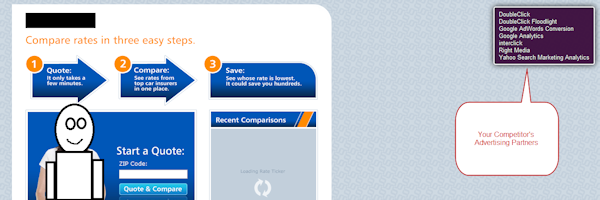Any industry landscape can become competitive with the addition of a new advertiser or two. In order to take your competition down, you’ll need as much information as possible on their digital strategy and the tactics they are implementing.
By understanding the keywords your competitors are bidding on, their account structure as well as the advertising partners they are utilizing, you can utilize this information to improve your own strategy.
Dissect URLs to Understand Competitor’s Account Structure
This is one of my favorite tactics. Many paid search management tools carry information within URL parameters just as a tool like Google Analytics does. You may seem something such as:
www.domain.com/business.jsp?src=goog&cmpn=pennsylvannia&adgroup= health+insurance+cheap+state&blah+blah+blah
This URL can tell you quite a bit about the account structure your competitor is using. For example, you can see that your competitor has split up campaigns by geo-locations. If a competitor is breaking down campaigns by geo-location, why should you?
- Performance: Brand awareness in one location may be deeper than others
- Regulations: Prices for products/services as well as advertising messaging may be highly regulated
- Service Area: Companies may only be looking to serve specific location due to demographics
- Messaging: An advertiser may want to deliver geo-specific messaging in text ads
If there is enough volume, splitting up your campaigns by geo-location can help boost campaign performance. By setting up more granular bidding strategy and rules, you’ll be able to boost results. Simple findings like this can really help you evolve your paid search strategy.
An optimized campaign structure is the basis for any top performing account. This information is not something SEM managers tend to boast about, so utilizing this method can help you understand if there are any changes you could make to your account to get ahead of the competition.
Here’s an example of an advertiser who is giving away a little too much information in their URL:

Understand Who Your Competitors Are Working With
Knowing where your competitors are spending money is important. Understanding what advertising partners they are using to drive traffic to their site can also help you get ahead of the completion.
There is a quick and easy way to quickly get a list of all the traffic and tools your competitors are using.
Head to www.Ghostery.com and download their free plugin. When this plugin is active and you visit a site, a list will populate automatically letting you know which tags fired when you reached the site. You’ll easily be able to tell what ad networks are being used and which optimization tools are being used as well.
Here is a screenshot of Ghostery in action:

This is much more efficient then combing through HTML code to search for tags and while it is not as powerful as Firebug, it’s quicker and easier to use. By knowing who your competitors are working with, you can invest additional media spend into these partners to test if any are valuable lead sources. You should make sure you follow through to the purchase/sale/quote process as tag often fire after completion of a specific event.
Understanding Keyword Strategies
Understanding the opportunity of your industry can help you grow your overall footprint on search engines. Google Insights, suggested search, and other keyword research tools can only tell you so much. How do you know if the keywords suggested will actually result in quality traffic?
Spyfu has a great tool that enables you to see what keywords that are being used in your competitors account. While not 100 percent accurate all of the time, utilizing Spyfu’s ‘Kombat’ tool can help you understand which keywords are being used in your competitor’s strategy that you are not buying.
How can this help? Here is an example – if you are managing an insurance campaign and have a very straight direct response strategy consisting of keywords such as ‘buy health insurance’, ‘get new insurance’ etc. You may be missing out on potential traffic that your competitors are taking advantage of.
By using Kombat, you can find additional keywords that may be out of your traditional direct response strategy and knowing that they are involved in your competitors strategy, can back up your recommendation that they keywords are at least worth testing.
Understanding the strategy and tactics of your competitors can only help you boost your own campaigns performance. So spend an hour researching your competitors with the above mentioned tactics and start improving your campaigns.
Branding vs. Customer Retention vs. Customer Acquisition
Digital media can play multiple roles within your overall marketing strategy. Understanding where your competitors are spending their money can help you plan how your industry is changing and better split up your marketing budget.
Here are a few simple questions you can answer by simply running a few Google searches and researching the partners you found by using Ghostery in the above mentioned tip.
- Does your competitor bid on their branded terms?
- Does your competitor have an active brand channel on youtube?
- Are media buys being used to promote the channel?
- Does your competitor utilize media buys on social media channels and promote conversation promoting conversation?
- Does your competitor have ads showing for search queries that contain ‘ customer service’ or ‘file a claim’ or any other post purchase activity for your industry?
Each channel can play multiple roles in your digital strategy and understanding where money is being invested by your competitors and how they are investing can help you understand your industry better.
With the information learned by completing the above mentioned tactics, you can make informed decisions and improve your own campaigns.

